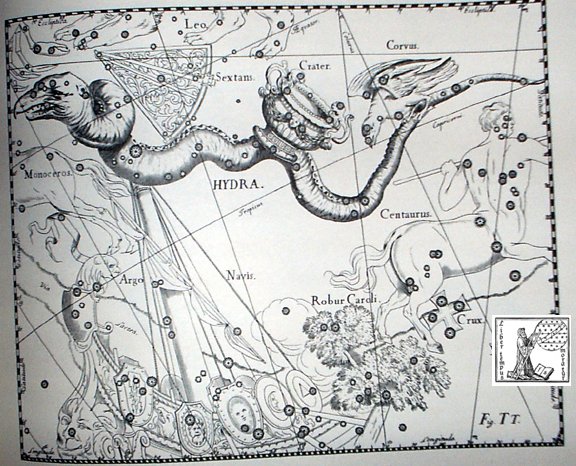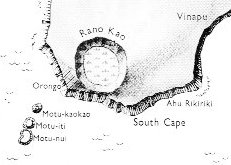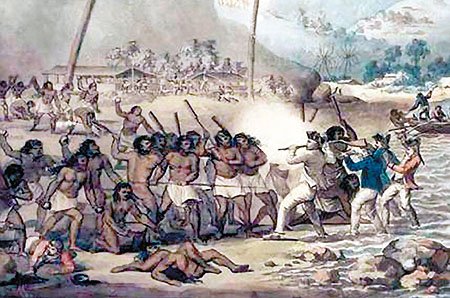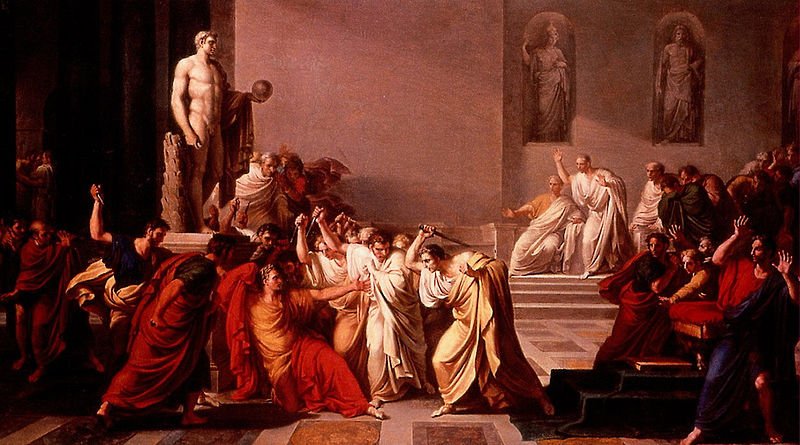102. The 'loop' of
Makoi had evidently
been completed
in Anakena 5 (186), i.e. at
the time when
the Explorers returned to Hanga Te Pau after
having left the same place in Maro 10 (161).
186 - 161 = 25 (a square belonging to Saturn =
Makoi):
|
Mercury |
Jupiter |
Venus |
Makoi |
Sun |
Moon |
Mars |
|
1 |
2 |
3 |
4 |
5 |
6 |
7 |
|
8 |
9 |
10 |
11 |
12 |
13 |
14 |
|
15 |
16 |
17 |
18 |
19 |
20 |
21 |
|
22 |
23 |
24 |
25 |
26 |
27 |
28 |
|
etc |
|
Makoi
The tree which on
T. was called miro,
Thespesia populnea. Van
Tilburg.
Makoikoi, kidney T.
Churchill.
Miro
T. 1. The tree Thespesia
populnea ... a fine tree
with bright-green heart-shaped
leaves and a yellow flower
resembling that of the fau,
but not opening wide. The fruit
is hemispherical and about twice
the size of a walnut, consisting
of brittle shell in which are
several septa, each containing a
single seed. The wood resembles
rosewood and is of much the same
texture. Formerly, this tree was
held sacred. Henry.
 |
 |
 |
 |
22 |
|
Ga1-29 |
Ga1-30 |
Ga2-1 |
|
TEJAT PRIOR |
FURUD |
CANOPUS |
|
INVISIBLY CLOSE TO THE SUN
(helical dates): |
18 |
|
MAY 14 |
15 |
16 (136 = 408 / 3) |
17 |
18 (*58 = 29 + 29) |
19 |
 |
 |
 |
 |
 |
 |
|
Ga2-24 (29
+ 25) |
Ga2-25 |
Ga2-26 (29 + 27) |
Ga2-27 (π) |
Ga2-28 |
Ga2-29 |
|
φ Gemini
(118.4) |
DRUS
= χ Carinae
(119.9) |
ω Cancri
(120.2) |
8h (121.7)
χ Gemini
(121.0),
NAOS
= Ζ Puppis
(121.3) |
ρ Puppis (122.0),
HEAP OF FUEL
= μ Cancri
(122.1), ζ Monocerotis (122.3),
ψ Cancri (122.6),
REGOR = γ Velorum
(122.7) |
TEGMINE
= Ζ Cancri
(123.3) |
|
July 17
(*118) |
18 |
19 (200) |
20 (*121 = 11 * 11) |
21 |
22 / 7 |
|
°July 13 |
14 |
15 (196) |
16 |
17 (*118 = 4 * 29½) |
18 |
|
'June 20 |
SOLSTICE |
22 (200 - 27) |
23 |
ST JOHN'S DAY |
25 (*96) |
|
... Midsummer is the flowering
season of the oak, which is the
tree of endurance and triumph,
and like the ash is said to
'court the lightning flash'. Its
roots are believed to extend as
deep underground as its branches
rise in the air - Virgil
mentions this - which makes it
emblematic of a god whose law
runs both in Heaven and in the
Underworld ... The month,
which takes its name from
Juppiter the oak-god, begins on
June 10th and ends of July 7th.
Midway comes St. John's Day,
June 24th, the day on which the
oak-king was sacrificially
burned alive. The Celtic year
was divided into two halves with
the second half beginning in
July, apparently after a
seven-day wake, or funeral
feast, in the oak-king's honour
... |
|
"June 6 (157) |
Maro
7 |
8 |
9 (*80 = *121 - 41) |
HANGA
TE PAU |
11 |
|
Makoi
named the place Hanga Te Pau,
'the landing site of Ira'.
So that they would remember (?
he aringa, literally, 'as
face'), the open side of
Hanga Te Pau was given this
name. Ira got up. They
all climbed to the top of the
hill. They climbed up on the
tenth day of the month of June 'Maro'.
They reached
the side crater (te
manavai) and looked around
carefully. Makoi said,
'This is the Manavai of
Hau Maka.' They
climbed farther and reached the
top. They saw the dark abyss and
the large hole (of the crater
Rano Kau). They all said,
'Here it is, young men, the dark
abyss of Hau Maka.' They
made camp and constructed a
house. Kuukuu got up,
worked the ground, and heaped up
the earth for the yam roots. |
|
INVISIBLY CLOSE TO THE SUN
(helical dates): |
|
JUNE 7 (*78) |
8 |
9 |
10 (161) |
11 |
12 |
 |
 |
 |
 |
 |
 |
|
Ga3-19 (29 + 49) |
Ga3-20 |
Ga3-21 |
Ga3-22 |
Ga3-23 |
Ga3-24 (29 + 54) |
|
The Knot (Ukdah) |
Rishu A.-13 (Head
of the Lion)
ψ Leonis (146.4),
RAS ELASET AUSTRALIS = ε Leonis
(146.6) |
VATHORZ PRIOR = υ Carinae
(147.9) |
|
Star-25 (Horse) /
ANA-HEU-HEU-PO-5
(Pillar where debates were held)
ALPHARD = α Hydrae
(142.3),
ω Leonis (142.6),
τ¹
Hydrae
(142.7) |
Al Tarf-7
ψ Velorum (143.3),
ALTERF (The End)
= λ Leonis,
τ² Hydrae
(143.4), ξ Leonis (143.5) |
A Hydrae
(144.1) |
UKDAH
= ι Hydrae
(145.4),
κ Hydrae (145.5),
SUBRA = ο Leonis
(145.8) |
 |
|
August 10 |
11 |
12 |
13 |
14 (*146) |
15 (227) |
|
°August 6 |
7 |
8 (220) |
9 |
10 |
11 (*143) |
|
'July 14 |
15 |
16 |
17 (*118 = 4 * 29½) |
18 |
19 (200) |
|
SIRIUS |
"July 1 |
Anakena
2 |
3 (*104) |
4
(185) |
HANGA
TE PAU |
|
... On the fifth day of the
month of July ('Anakena'),
they all got up, went downhill,
went on, and reached Hanga Te
Pau. |
|
CLOSE TO THE FULL MOON (and
nakshatra dates): |
|
DECEMBER 7 |
8 |
9 |
10 |
11 (345) |
12 (*266) |
|
BUNDA (Foundation) / KAKKAB
NAMMAΧ (Star of Mighty Destiny) |
θ Piscis Austrini
(330.1), λ Oct. (330.7) |
|
Al Sa'd al Su'ud-22 /
Emptiness-11
(Rat)
TSIN = 36 Capricorni
(325.2),
ALPHIRK = β Cephei
(325.7),
SADALSUD = Β Aquarii,
ξ Gruis (325.9) |
no star listed (326) |
CASTRA = ε Capricorni
(327.2),
BUNDA
= Ζ Aquarii
(327.5) |
Mahar sha hi-na Shahū-26
(Western One in the Tail of the
Goat)
NASHIRA = γ Capricorni
(328.0), ν Oct. (328.3),
AZELFAFAGE = π¹
Cygni,
κ Capricorni (328.7) |
Arkat sha hi-na Shahū-27
(Eastern One in the Tail of the
Goat)
ENIF (the Nose) = ε Pegasi,
ERAKIS = μ Cephei
(329.2),
46
Capricorni, JIH (the Sun) = κ
Pegasi
(329.3), ι Piscis Austrini
(329.4), λ Capricorni (329.6), ν
Cephei (329.7),
DENEB
ALGIEDI = δ Capricorni
(329.8) |
|
February 9 (40) |
10 |
11 |
12 (408) |
13 (*329) |
All Hearts' Day |
|
... On February 9 the Chorti
Ah K'in, 'diviners', begin
the agricultural year. Both the
260-day cycle and the solar year
are used in setting dates for
religious and agricultural
ceremonies, especially when
those rituals fall at the same
time in both calendars. The
ceremony begins when the
diviners go to a sacred spring
where they choose five stones
with the proper shape and color.
These stones will mark the five
positions of the sacred
cosmogram created by the ritual.
When the stones are brought back
to the ceremonial house, two
diviners start the ritual by
placing the stones on a table in
a careful pattern that
reproduces the schematic of the
universe. At the same time,
helpers under the table replace
last year's diagram with the new
one. They believe that by
placing the cosmic diagram under
the base of God at the center of
the world they demonstrate that
God dominates the universe.
The priests place the stones in
a very particular order. First
the stone that corresponds to
the sun in the eastern, sunrise
position of summer solstice is
set down; then the stone
corresponding to the western,
sunset position of the same
solstice. This is followed by
stones representing the western,
sunset position of the winter
solstice, then its eastern,
sunrise position. Together these
four stones form a square. They
sit at the four corners of the
square just as we saw in the
Creation story from the Classic
period and in the Popol Vuh.
Finally, the center stone is
placed to form the ancient
five-point sign modern
researchers called the quincunx
... |
|
°February 5 |
6 |
7 |
8 (*324) |
9 (40) |
10 |
|
'January 13 (378) |
14 |
15 (*300) |
16 |
17 |
18 (383) |
|
"December 30 |
Ko Koró
31 (*285) |
"January 1 |
Tua haro
2 |
3 (368) |
4 |
|
INVISIBLY CLOSE TO THE SUN
(helical dates): |
|
JUNE 13 (*84) |
14 |
15 |
16 |
17 (168 = 12 * 14) |
18 |
19 |
 |
 |
 |
 |
 |
 |
 |
|
Ga4-1 (107 - 23) |
Ga4-2 |
Ga4-3 |
Ga4-4 |
Ga4-5 |
Ga4-6 |
Ga4-7 |
|
υ¹ Hydrae (148.4),
RAS
ELASET
BOREALIS = μ Leonis
(148.7) |
TSEEN KE (Heaven's Record) =
φ Velorum
(149.9) |
ν Leonis (150.1), π Leonis
(150.6) |
υ² Hydrae (151.8) |
Al Jabhah-8 /
Maghā-10 /
Sharru-14 (King)
10h (152.2)
AL JABHAH = η Leonis
(152.4),
REGULUS
= α Leonis
(152.7) |
λ Hydrae
(153.2) |
ADHAFERA = ζ Leonis, TANIA
BOREALIS = λ Ursae Majoris,
SIMIRAM = ω Carinae
(154.7) |
|
August 16
(*148) |
17 (229) |
18 |
19 |
20 (*152) |
21 |
22 |
|
°August 12 |
13 (225) |
14 |
15 |
16 (*148) |
17 |
18 |
|
'July 20 (201) |
21 |
22 / 7 |
23 |
24 (*125) |
25 |
26 |
|
"July 6 (*107) |
Anakena
7 |
8 |
9 |
TE
POU |
11 (192) |
12 |
|
CLOSE TO THE FULL MOON (and
nakshatra dates): |
|
LUCIA |
14 (*268) |
DECEMBER 15 |
16 (350) |
17 |
18 |
19 |
|
KUH (Weeping)
= μ Capricorni
(331.4), γ Gruis (331.5) |
no star listed (332) |
η Piscis Austrini (333.4) |
22h (334.8)
KAE UH (Roof) = ο
Aquarii
(334.0),
AL KURHAH = ξ Cephei
(334.4),
SADALMELIK
= α Aquarii,
AL DHANAB = λ Gruis
(334.6), ι Aquarii, ν Pegasi
(334.7) |
ι Pegasi (335.0),
ALNAIR = α Gruis
(335.1), μ Piscis Austrini,
υ Piscis Austrini (335.3),
WOO (Pestle) = π Pegasi
(335.7),
BAHAM = θ Pegasi,
τ Piscis Austrini (335.8) |
ζ Cephei
(336.2),
λ Cephei
(336.3), -/270 Lac. (336.7),
λ Piscis Austrini (336.8) |
μ Gruis (337.0),
ε Cephei
(337.2), 1/325 Lac. (337.3),
ANCHA = θ Aquarii
(337.4), ψ Oct. (337.5), α
Tucanae (337.9) |
|
February 15 |
16 |
17 (14 * 29½) |
18 (414) |
19 |
20 |
21 (52) |
|
°February 11 |
12 |
13 |
2-14 |
15 |
16 (*332) |
17 (413) |
|
'January 19 (384) |
20 |
21 |
22 |
23 (*308) |
24 |
25 |
|
"January 5 |
Tua haro
6 |
7 (372) |
8 |
9 |
10 (*295) |
11 |
|
They took
their provisions with them,
carrying them on their
shoulders, went on, and
reached Te Pou. They
made camp and slept in Te
Pou on the tenth day of
the month of July ('Anakena').
|
|

... Horapollo, the
grammarian of Alexandria,
about A.D. 400, tells us
that the crane was the
symbol of a star-observer in
Egypt ... |
However, 186 ("July 5) -
163 ("June 12 at manu kake in Ga3-1) = 23 (a Jupiter
number) and this could allude to 21 December
(355) - 28
November (332 = 355 - 23) as the measure for the circuit
of Lono:
... The correspondence between the winter
solstice and the kali'i rite of the
Makahiki is arrived at as follows:
ideally, the second ceremony of 'breaking
the coconut', when the priests assemble at
the temple to spot the rising of the
Pleiades, coincides with the full moon (Hua
tapu) of the twelfth lunar month (Welehu). In
the latter eighteenth century, the Pleiades
appear at sunset on 18 November. Ten days
later (28 November), the Lono effigy
sets off on its circuit, which lasts
twenty-three days, thus bringing the god
back for the climactic battle with the king
on 21 December, the solstice (= Hawaiian 16
Makali'i). The correspondence is
'ideal' and only rarely achieved, since it
depends on the coincidence of the full moon
and the crepuscular rising of the
Pleiades ...
|
INVISIBLY CLOSE TO THE SUN
(helical dates): |
|
MAY 20 (140) |
21 |
22 |
23 (*63) |
24 (144 = 12 * 12) |
 |
 |
 |
 |
 |
|
Ga3-1 (60) |
Ga3-2 |
Ga3-3 |
Ga3-4 |
Ga3-5 |
|
AL TARF
(The End)
= β Cancri
(124.3)
RAS
ALGETHI (α Herculis)
|
χ Cancri
(125.2),
BRIGHT FIRE
= λ Cancri
(125.4) |
AVIOR = ε Carinae
(126.4), φ Cancri (126.8) |
ο Ursa Majoris (127.4) |
Pushya-8
υ Cancri (128.1),
θ CANCRI
(128.2) |
|
July 23 (204) |
24 (*125) |
25 |
26 |
27 (208) |
|
°July 19 (200) |
20 (*121) |
21 |
22 / 7 |
23 (204) |
|
26 (177 = 6 * 29½) |
'June 27 |
28 |
29 (*100) |
SIRIUS |
|
"June 12
(*83) |
13 |
14 (165 + 365) |
Maro 15
(531
= 18
* 29½) |
16 |
|
CLOSE TO THE FULL MOON (and
nakshatra dates): |
|
NOVEMBER 19 |
20 |
21 (325) |
23 (*246 = 6 * 41) |
23 |
|
GREDI
= α Capricorni
(307.2), σ Capricorni
(307.5),
ALSHAT
= ν Capricorni
(307.9) |
Al Sa’d al Dhabih-20 /
Ox / Herd Boy-9
(Buffalo)
DABIH = β Capricorni
(308.0), κ Sagittarii
(308.1),
SADIR = γ Cygni
(308.4),
PEACOCK
= α Pavonis
(308.7) |
OKUL = π
Capricorni
(309.6),
BOS = ρ
Capricorni
(309.9) |
ο Capricorni (310.2), θ
Cephei (310.5) |
ROTTEN MELON = ε Delphini,
φ Pavonis (311.2), η
Delphini (311.4), ζ
Delphini, ρ Pavonis (311.7) |
|
January 22 |
23 |
24 (*309) |
25 (390) |
26 |
|
°January 18 (384) |
19 |
20 |
21 (*306) |
22 |
|
'December 26 (360) |
27 |
28 |
29 |
30 (*284) |
|
"December 12 |
LUCIA |
14 (348) |
15 |
16 (*270) |
|
Makoi got up and
began to familiarize himself
with the (new) land. (This
took place) on the fifteenth
day of the month of June ('Maro').
He went toward the sheer
face of the rocks (titi o
te opata), was
astonished (aaa),
came up to the middle (of
the outer rim of the
crater), and stood at the
very edge.

He looked down and saw the 'Pu
Mahore of Hau
Maka' (on the coast)
and said, 'There it is, the
hole of the mahore
fish of Hau Maka!' He
turned his face and looked
toward the back (i.e., in
the direction of the
crater). No sooner had he
seen how the dark abyss
opened up (below him), when
a fragrant breeze came
drifting by. Again Makoi
said, 'This is the dark
abyss of Hau Maka'.
He turned around, walked on
in utter amazement, and
arrived at the house. He
spoke to Ira, 'Hey
you, my friends! How
forgetful we (truly) are.
This place is adequate (?
tau or 'beautiful'), the
dark abyss lies there
peacefully!'
Ira
replied, 'And what should
that remind us of up here?'
All arose and climbed up.
They went on and arrived;
they all had a good look (at
the inside of the crater).
They returned home and sat
down. Night fell, and they
went to sleep. |
Alphard was a
pillar where debates were held - Ira and Makoi
debated how names should be
given:
... Then Ira spoke again:
'How did you name them, last-born?'
Makoi replied, 'This is what
happened, this is how I gave the
names. I wrote (ta) Te
Manavai A Hau Maka on the
surface of a banana leaf (kaka),
and this is how I left it.' This is
how Makoi remembered it.
No sooner had he said this, when
Ira gew angry and quarrelled
with Makoi. He said the
following (to him): 'You did not pay
attention, last-born, and you did
not give the (full) name. This is
how it should be: the Manavai of Hau
Maka of Hiva, in memory (mo
aringa ora) of the father, of
his dream soul.'
Makoi
replied, 'In Hiva the land
belongs to him - this land here is
mine, not his!'
They stayed (there longer)
...
But on Hawaii, north of the equator, the
quarrel at the turn of the year was
not verbal but life threatening in
character:
... A vestige of the practice of
putting the king to death at the end
of a year's reign appears to have
survived in the festival called
Macahity, which used to be
celebrated in Hawaii during the last
month of the year. About a hundred
years ago a Russian voyager
described the custom as follows:
'The taboo Macahity is not
unlike to our festival of Christmas.
It continues a whole month, during
which the people amuse themselves
with dances, plays, and sham-fights
of every kind. The king must open
this festival wherever he is. On
this occasion his majesty dresses
himself in his richest cloak and
helmet, and is paddled in a canoe
along the shore, followed sometimes
by many of his subjects. He embarks
early, and must finish his excursion
at sunrise.
The strongest and most expert of the
warriors is chosen to receive him on
his landing. The warrior watches the
canoe along the beach; and as soon
as the king lands, and has thrown
off his cloak, he darts his spear at
him, from a distance of about thirty
paces, and the king must either
catch the spear in his hand, or
suffer from it: there is no jesting
in the business. Having caught it,
he carries it under his arm, with
the sharp end downwards, into the
temple or heavoo. On his
entrance, the assembled multitude
begin their sham-fights, and
immediately the air is obscured by
clouds of spears, made for the
occasion with blunted ends.
Hamamea (the king) has been
frequently advised to abolish this
ridiculous ceremony, in which he
risks his life every year; but to no
effect. His answer always is, that
he is as able to catch a spear as
any one on the island is to throw it
at him. During the Macahity,
all punishments are remitted
throughout the
country;
and no person can leave the place in
which he commences these holidays,
let the affair be ever so important
...

... Cook's first visit, to Kaua'i
Island in January 1778, fell within
the traditional months of the New
Year rite (Makahiki). He
returned to the Islands late in the
same year, very near the
recommencement of the Makahiki
ceremonies. Arriving now off
northern Maui, Cook proceeded to
make a grand circumnavigation of
Hawai'i Island in the prescribed
clockwise direction of Lono's yearly
procession, to land at the temple in
Kealakekua Bay where Lono begins and
ends his own circuit. The British captain took his leave
in early February 1779, almost
precisely on the day the Makahiki
ceremonies closed. But on his way
out to Kahiki, the Resolution sprung
a mast, and Cook committed the
ritual fault of returning
unexpectedly and unintelligibly. The
Great Navigator was now hors
catégorie, a dangerous condition
as Leach and Douglas have taught us,
and within a few days he was really
dead - though certain
priests of Lono did afterward ask
when he would come back ...

... The brutes of spring caused the
downfall of both Captain Cook and
Julius Caesar. We are close to the
key myth of mankind, that which
explains the regeneration of sun and
of growth. Once at least some people
kept the tradition living. I became
interested in what really happened
at March 15 and reopened Henrikson
to find out.
Caesar was forewarned of the threat
by the prophet Spurinna, who told
him that a great threat was coming
at Idus Martiae or
just before. The day arrived and
Caesar was still living, walking to
his meeting with the Senate when he
happened to encounter Spurinna and
told him jokingly that he was still
alive. Spurinna calmely answered
that the day had yet not ended.
The Romans divided their months in
two parts and the dividing point was
Idus, which in some way was
connected with the full moon. March 15 was the
midpoint of March, which is close to spring
equinox.
The old agricultural year defined
the beginning of the year to the
time when sun returned, and it was
connected with Mars:
|
ARIES: |
|
1 |
Ashvini |
β and γ Arietis |
Horse's head |
27 = 16
+ 11 |
|
wife of the Ashvins |
Sheratan and Mesarthim |
April 17 (107) |
|
2 |
Bharani |
35, 39, and 41 Arietis |
Yoni, the female organ
of reproduction |
41 = 27
+ 14 |
|
the bearer |
Musca Borealis |
May 1 (121) |
|
TAURUS: |
|
3 |
Krittikā |
M 45 Tauri |
Knife or spear |
55 = 41
+ 14 |
|
the nurses of
Kārttikeya |
The Pleiades |
May 15 (135) |
|
... The star cluster
Krittika ...
sometimes known as
Kārtikā, corresponds to
the open star cluster
Pleiades in Indian
astronomy and
Jyotisa (Hindu
astrology). The name
literally translates to
'the cutters' ... In
Hindu mythology, the god
Murugan (Skanda/Subrahmanya/Kartikeya)
was raised by the six
sisters known as the
Krttikā and thus
came to be known as
Kārtikeya (literally
'Him of the Krttikā').
According to the
Mahābhārata, Murugan
was born to Agni
and
Svāhā, after the
latter impersonated six
of the seven wives of
the Saptarsi and
made love to him. The
Saptarshi, hearing
of this incident and
doubting their wives'
chastity, divorced them.
These wives then became
the Krttikā ... |
... Skanda (literally
'the jumping one' or 'the
hopping one') is the planet
Mars, also called Kartikeya,
inasmuch as he was borne by the
Krittika, the Pleiades.
Mbh. 9.44-46 (Roy trans. vol. 7,
pp. 130-43). It should be
emphasized, aloud and strongly,
that in Babylonian astronomy
Mars is the only planetary
representative of the Pleiades.
See P. F. Gössmann.
Planetarium Babylonicum
(1950), p. 279: 'In der
Planetenvertretung kommt für die
Plejaden nur Mars in Frage.'
... Ancient
people were fascinated with
the periodic backward loops
turned by Mars every two
years ...
The Mahabharata insists
on six as the number of
the Pleiades as well as of the
mothers of Skanda and
gives a very broad and wild
description of the birth and the
installation of Kartikeya
'by the assembled gods ... as
their generalissimo', which is
shattering, somehow, driving
home how little one understands
as yet.
The least which can be said,
assuredly: Mars was 'installed'
during a more or less close
conjunction of all planets; in
Mbh. 9.45 (p. 133) it is
stressed that the powerful gods
assembled 'all poured water upon
Skanda, even as the gods
had poured water on the head of
Varuna, the lord of
waters, for investing him with
dominion'. And this
'investiture' took place at the
beginning of the Krita Yuga,
the Golden Age
...

|




















